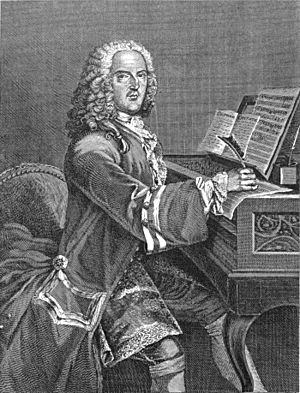Louis-Nicolas Clérambault facts for kids
Quick facts for kids
Louis-Nicolas Clérambault
|
|
|---|---|
 |
|
| Born | 19 December 1676 Paris, France
|
| Died | 26 October 1749 (aged 72) Paris, France
|
| Occupation | Composer and organist |
Louis-Nicolas Clérambault (born December 19, 1676 – died October 26, 1749) was a talented French musician. He is most famous for being an organist, someone who plays the organ, and a composer, who writes music. Clérambault was born and passed away in Paris, France.
About Louis-Nicolas Clérambault
Louis-Nicolas Clérambault grew up in a family of musicians. His father and two of his own sons were also musicians! From a very young age, he learned to play the violin and the harpsichord. A harpsichord is an old musical instrument similar to a piano. He also studied the organ with a famous teacher named André Raison. Clérambault learned how to write music (called composition) and how to sing with another teacher, Jean-Baptiste Moreau.
Clérambault became an organist at a church called the Grands-Augustins. He also started working for Madame de Maintenon, an important lady in the French royal court. After the death of King Louis XIV and another organist named Guillaume-Gabriel Nivers, Clérambault took over Nivers' job. He became the organist at the Saint-Sulpice church and at the royal house of Saint-Cyr. This house was a special school for young girls from noble families who were not rich.
At Saint-Cyr, Clérambault was in charge of all the music. He played the organ, led the chants, and directed the choir. It was in this role that he became very good at creating a type of music called the "French cantata." A cantata is a piece of music for singers and instruments, often telling a story. He was known as the best at this style. In 1719, he also took over from his old teacher, André Raison, as the organist at the Grands-Jacobins church.
One of his religious music pieces, the Motet du Saint Sacrement in G major, was one of the first French musical works ever performed in Philadelphia, USA.
Clérambault's Musical Works
Louis-Nicolas Clérambault wrote many different kinds of music. His most important published works include:
- A large number of religious pieces for singers and choirs. These include motets (short religious songs), hymns, and longer pieces like the Magnificat and Te Deum.
- More than 25 cantatas that were not religious. These often told stories inspired by old Greek and Roman myths.
- Sonatas for the violin and basso continuo. A sonata is a piece for one or more instruments, and basso continuo is a type of musical accompaniment.
- A book of dance pieces for the harpsichord from 1704. In this book, he used a style called the "unmeasured prelude," which means the music doesn't have a strict rhythm at the beginning.
- A book of organ pieces from 1710, which had two suites. A suite is a collection of musical pieces, often dances. These organ pieces were known for their beautiful melodies. Clérambault planned to write more of these, but he never finished the full collection.
See also
 In Spanish: Louis-Nicolas Clérambault para niños
In Spanish: Louis-Nicolas Clérambault para niños
- French organ school

